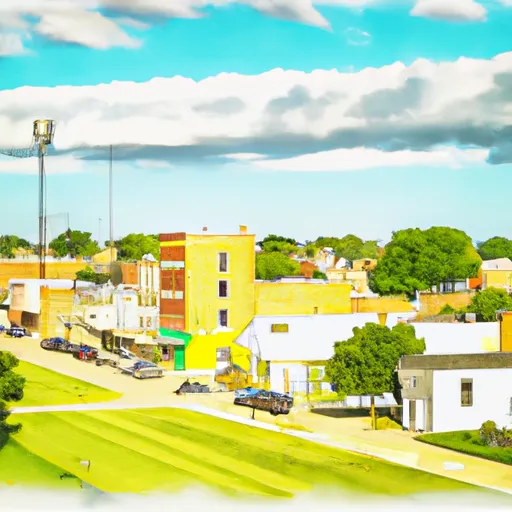-
 Snoflo Premium
Snoflo Premium
Get unlimited access to all our content
With no Ad interruptions! - Start Your Free Trial Login with existing account
Waterloo
Eden Index
Climate
7.9
•
Recreation
2.8
•
Community
3.5
•
Safeguard
5.0/10

Waterloo, Nebraska is a small town located in Douglas County. It experiences a humid continental climate, characterized by hot summers and cold winters. Summers are often sunny and warm, with temperatures ranging from the mid-80s to low 90s Fahrenheit. Winters can be bitterly cold, with temperatures dropping below freezing and occasional snowfall.
Hydrology constituents in Waterloo include the Elkhorn River, which flows near the town and provides opportunities for water-based activities such as fishing, boating, and kayaking. The river also contributes to the local ecosystem and supports diverse wildlife.
In terms of outdoor recreation, Waterloo offers several opportunities for nature enthusiasts. Nearby Cunningham Lake offers fishing, hiking trails, and picnic areas. Chalco Hills Recreation Area, a short drive away, provides opportunities for hiking, biking, and birdwatching. With its picturesque landscapes, these areas offer a chance to connect with nature and enjoy the outdoors.
In conclusion, Waterloo, Nebraska experiences a typical Midwestern climate, with hot summers and cold winters. Its hydrology constituents, mainly the Elkhorn River, offer recreational opportunities such as fishing and boating. Additionally, nearby parks and recreation areas provide ample opportunities for outdoor activities and exploration.
What is the Eden Index?
The Snoflo Eden Index serves as a comprehensive rating system for regions, evaluating their desirability through a holistic assessment of climate health, outdoor recreation opportunities, and natural disaster risk, acknowledging the profound impact of these factors on livability and well-being.
Climate Health Indicator (CHI): 7.9
Waterloo receives approximately
772mm of rain per year,
with humidity levels near 83%
and air temperatures averaging around
11°C.
Waterloo has a plant hardyness factor of
5, meaning
plants and agriculture in this region thrive during a short period during spring and early summer. Most
plants will die off during the colder winter months.
By considering the ideal temperature range, reliable water supplies, clean air, and stable seasonal rain or snowpacks, the Climate Health Indicator (CHI) underscores the significance of a healthy climate as the foundation for quality living.
A healthy climate is paramount for ensuring a high quality of life and livability in a region, fostering both physical well-being and environmental harmony. This can be characterized by ideal temperatures, reliable access to water supplies, clean air, and consistent seasonal rain or snowpacks.
Weather Forecast
Streamflow Conditions
Elkhorn
Area Rivers
Elkhorn
Snowpack Depths
Elkhorn
Reservoir Storage Capacity
Elkhorn
Groundwater Levels
Recreational Opportunity Index (ROI): 2.8
The Recreational Opportunity Index (ROI) recognizes the value of outdoor recreational options, such as parks, hiking trails, camping sites, and fishing spots, while acknowledging that climate plays a pivotal role in ensuring the comfort and consistency of these experiences.
Access to outdoor recreational opportunities, encompassing activities such as parks, hiking, camping, and fishing, is crucial for overall well-being, and the climate plays a pivotal role in enabling and enhancing these experiences, ensuring that individuals can engage in nature-based activities comfortably and consistently.
Camping Areas
| Campground | Campsites | Reservations | Toilets | Showers | Elevation |
|---|---|---|---|---|---|
| Centralia Lake | None | 1,285 ft | |||
| Weeping Water | 25 | 1,081 ft | |||
| Iron Horse Trail Lake | 11 | 1,132 ft | |||
| Burchard Lake State Wildlife Area | 10 | 1,336 ft | |||
| Louisville Lakes State Rec Area | 300 | 1,032 ft | |||
| Oregon Trail RV Park | 16 | 1,182 ft | |||
| Eugene T. Mahoney State Park | 150 | 1,167 ft |
Nearby Ski Areas
Catastrophe Safeguard Index (CSI):
The Catastrophe Safeguard Index (CSI) recognizes that natural disaster risk, encompassing floods, fires, hurricanes, and tornadoes, can drastically affect safety and the overall appeal of an area.
The level of natural disaster risk in a region significantly affects safety and the overall livability, with climate change amplifying these risks by potentially increasing the frequency and intensity of events like floods, fires, hurricanes, and tornadoes, thereby posing substantial challenges to community resilience and well-being.
Community Resilience Indicator (CRI): 3.5
The Community Resilience Indicator (CRI) recognizes that education, healthcare, and socioeconomics are crucial to the well-being of a region. The CRI acknowledges the profound impact of these elements on residents' overall quality of life. By evaluating educational resources, healthcare accessibility, and economic inclusivity, the index captures the essential aspects that contribute to a thriving community, fostering resident satisfaction, equity, and social cohesion.

